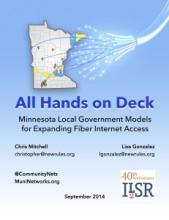Greater Minnesota Partnership Focuses on Non-Metro Need - Community Broadband Bits Podcast 136

Like many states, Minnesota has a major metro area that generally has higher quality Internet access than non-metro communities. The Greater Minnesota Partnership, a coalition of businesses, chambers, nonprofits, and cities from across the state, have made improving Internet access a major priority in their efforts to influence the state legislature.
This week, we talk with Dan Dorman, Executive Director of the Greater Minnesota Partnership. He is also a former Minnesota state Rep and remains a small business owner.
We discuss the need to improve access even as major cable lobbyists fight in the capital to preserve the status quo. The Partnership believes state barriers to community networks should be removed. Dorman offers a unique perspective as a former member of the Minnesota Legislature. He knows what it is like to be lobbied constantly by one side of the issue but rarely hear from the other. Fortunately, the Greater Minnesota Partnership is working to provide that other side as best it can. We previously discussed the Border-to-Border fund in episode 119.
This show is 28 minutes long and can be played on this page or via Apple Podcasts or the tool of your choice using this feed.
Transcript below.
We want your feedback and suggestions for the show-please e-mail us or leave a comment below.
Listen to other episodes here or view all episodes in our index. See other podcasts from the Institute for Local Self-Reliance here.
Thanks to Persson for the music, licensed using Creative Commons. The song is "Blues walk."


